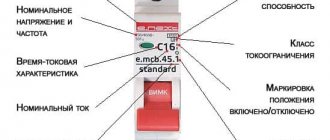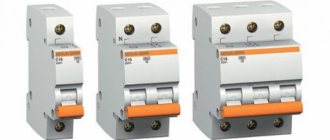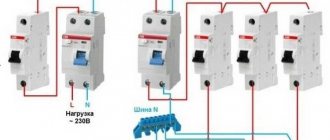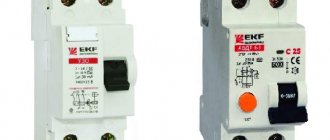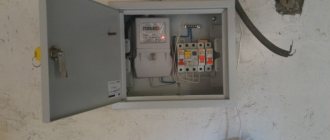Circuit breaker (automatic)
is an installation electrical product designed to protect electrical wiring from electric current exceeding the permissible value by opening the load circuit.
The photograph shows a modular single-pole circuit breaker of type BA101 with shutdown characteristic C, designed for operation in an alternating voltage network of 220 V and rated for a protection current of 10 A. These data are usually indicated on the front panel of the machine.
Automatic switches are produced in accordance with the technical requirements of GOST 9098-78 “Low-voltage automatic switches”.
The machine simultaneously performs two types of electrical wiring protection - against instantaneous current surges, for example, in the event of a short circuit in the electrical wiring that exceeds several times the rated one, and slow thermal protection, which is triggered when the rated load current is slightly exceeded for 15-60 minutes.
Thermal protection is made specially slow to eliminate false alarms of the machine. For example, a machine with a nominal value of 25 A is loaded with a current of 15 A. You turned on a vacuum cleaner, which will add another 10 A. But at the moment of starting, any engine consumes a current much higher than the rated one, and when the vacuum cleaner was turned on, its current consumption could momentarily increase to 15 A. As a result for a short time, the current flowing through the machine will be 30 A. But due to the inertia of the thermal protection, the machine does not operate.
Main types of switches
There are three main types of AVs, differing from each other in design and designed to work with loads of different sizes:
- Modular. It got its name because of its standard width, a multiple of 1.75 cm. It is designed for small currents and is installed in household power supply networks, for a house or apartment. As a rule, this is a single-pole or two-pole circuit breaker.
- Cast. So called because of the cast body. Can withstand up to 1000 Amps and is used primarily in industrial networks.
- Airborne. Designed to work with currents up to 6300 Amperes. Most often this is a three-pole machine, but now devices of this type are also produced with four poles.
A single-phase protective circuit breaker is a circuit breaker that is most common in household networks. It comes in 1- and 2-pole types. In the first case, only the phase conductor is connected to the device, and in the second case, the neutral conductor is also connected.
In addition to the listed types, there are also residual current devices, designated by the abbreviation RCD, and differential circuit breakers.
The former cannot be considered full-fledged AVs; their task is not to protect the circuit and the devices included in it, but to prevent electric shock when a person touches an open area. A differential circuit breaker is an AV and an RCD combined in one device.
Number of poles
As already mentioned, the circuit breaker has poles - from one to four.
Selecting a device for a circuit based on their number is not at all difficult; you just need to know where different types of AVs are used:
- Single-pole circuits are installed to protect lines that include sockets and lighting fixtures. They are mounted on the phase wire without touching the neutral wire.
- The two-terminal network must be included in the circuit to which household appliances with sufficiently high power are connected (boilers, washing machines, electric stoves).
- Three-terminal networks are installed in semi-industrial networks, to which devices such as well pumps or auto repair shop equipment can be connected.
- Four-pole AVs allow you to protect electrical wiring with four cables from short circuits and overloads.
The use of machines of different polarities is shown in the following video:
Circuit breaker design
Its internal design is not so simple.
The housing contains:
- Cocking mechanism;
- Thermal installation screw;
- Bimetallic thermal release;
- Electromagnetic coil release;
- Arc chamber;
- Power contacts;
- Exhaust channel for hot gases. Each of these elements performs a specific job. Read on the topic - what is a difavtomat, how to connect it.
The cocking mechanism is connected to a toggle switch, and power contacts are installed at its ends. They transmit electric current from the incoming terminals to the outgoing terminals.
A bimetallic (thermal) release is a plate that bends when heated, disconnecting the power contacts.
This release is designed to stop the current supply if its strength does not have a peak value. If the current is slightly exceeded, over time the plate will heat up and the contacts will open. That is, this release is triggered after a certain time.
The screw adjusts the gap between the plate and the contact. This screw is adjusted at the factory. The electromagnetic release is designed to instantly de-energize the network. It operates only when exposed to high currents that occur during a short circuit. When one of the releases is triggered, an electric arc will inevitably occur between the contacts, and the greater the current, the stronger it is.
To prevent this arc from leading to damage to the elements of the switch, its design includes an arc suppression chamber, which extinguishes the resulting arc within itself.
With all this, gases with elevated temperatures are formed inside, which are discharged through a special channel. Structurally, all circuit breakers are almost the same, but their operating parameters differ.
There are certain criteria for selecting circuit breakers, which take into account their parameters. Connecting a pass-through switch, diagrams, installation features, protection
Time-current characteristic
With the same power, the current values over time can vary, and significantly. This may lead to false protection activation.
To eliminate false shutdowns when electrical parameters are exceeded for a short time, switches with specified time-current characteristics (TCC) are used. These response characteristics allow you to select protection with a specific response time, thereby avoiding false trips without reducing the reliability of the protection.
The devices also differ in current limiting class. The current limiter helps to shed the load faster.
Circuit breaker functions
As the name suggests, it is a switch that turns off automatically. That is, himself, in certain cases. From the second name - circuit breaker - it is intuitively clear that this is some kind of automatic device that protects something.
Here are examples of the installation and use of such machines - when installing an apartment meter and when replacing electrical wiring in an apartment.
Now more details. The circuit breaker trips and turns off in two cases - in case of overcurrent, and in case of short circuit (short circuit).
Overcurrent occurs due to faulty consumers, or when there are too many consumers. Short circuit is a mode when all the power of the electrical circuit is spent on heating the wires, while the current in this circuit is the maximum possible. More details will follow.
In addition to protection (automatic shutdown), machines can be used to manually turn off the load. That is, like a switch or a regular “advanced” switch with additional options.
Another important function (this goes without saying) is the connection terminals. Sometimes, even if the protection function is not particularly needed (and it never hurts), the terminals of the circuit breaker can be very useful. For example, as shown in the article Laying the input cable from the gander to the meter.
Purpose of devices
The main function assigned to circuit breakers is to protect the cable from short circuits and overload. In addition, the set of tasks for the device includes:
- transmission of rated load current during long-term use;
- stable maintenance of the network voltage potential with a guarantee of its insulation;
- the ability to manually control the state of the power contact;
- the ability to determine when an overload occurs and provide the necessary time for safe operation, after which power is removed from the connected consumers.
It is important to choose the right type of electrical circuit breaker, taking into account the technical characteristics of the network, since frequent power outages can have disastrous consequences for the connected devices.
To do this, it is worth understanding how a circuit breaker works. A device designed for high power is not always appropriate, since a dangerous situation in a domestic area may not be recognized. Current strength that goes beyond the permissible norm for the cable is often not detected by the circuit breaker as an emergency position. Then a short circuit can be caused by melting of the insulation, but by this time there is a risk of fire. A circuit breaker device with a lower power can often and regularly stop the supply of voltage to the consumer. As a result, the machine will stop functioning due to contact failure.
Normal operating mode
In normal mode, a current flows through the circuit breaker that is less than or equal to the rated current.
In this case, the supply voltage is supplied to the upper terminal, which is connected to the fixed contact.
From the latter, the current flows to the moving contact, then through a flexible copper conductor to the solenoid.
Next, the current from the solenoid flows to the release (thermal relay) and then to the terminal located below. It is she who connects to electricity consumers.
Marking
Marking – symbols, is made on the body of the device. It contains the technical characteristics of the circuit breaker, the decoding is taken from reference books. From the information on the front side you can determine:
- Manufacturer (brand) of the device.
- Linear series – device model.
- Rated current value of the device.
- Rated voltage value.
- Maximum trip current.
- Current limiting class.
- Connection diagram, terminal designation.
Other information can also be applied to any side of the device. The technical description of the device supplements the information on the product (current limiting class, categories of devices, series of circuit breakers).
Overload mode
Overload mode is when the current consumed by the load connected to the machine becomes higher than the rated value of the device. In this case, the current that passes through the release causes heating of the bimetal plate, which leads to an increase in its bending. This causes the release mechanism to operate. At this moment, the machine turns off and the circuit opens.
Thermal protection does not work instantly, since it takes some time for the plate to heat up. And it varies depending on how much the rated current is exceeded. The time period can vary from a couple of seconds to an hour. The delay will allow you to get rid of power outages during a short and random increase in current. Often such excesses can be observed when starting the electric motor.
Electrician 7.8 program or computer calculation method for the machine
On the website of electrical engineering programs you can download and install an accessible calculation calculator for free on your computer. I showed the address with a picture.
Downloading, installation and operation are described in a separate article. I have tested several features of this program. Works fine. The calculation result is averaged. You can use it.
You will have to consider 2 factors:
- The site runs on a free website builder and is filled with intrusive advertising.
- The author does not take responsibility for the final result of the calculations. You will have to check it manually.
In general, the program is suitable for novice electricians to create the initial diagram of their project.
How does a machine operate in short circuit mode?
In the event of a short circuit, the operating principle of the circuit breaker is different. During a short circuit, the current in the circuit increases sharply and many times to values that can melt the wiring, or rather the insulation of the electrical wiring. In order to prevent such a development of events, it is necessary to immediately break the chain. This is exactly how an electromagnetic release works.
It will be interesting➡ Electrolizsols, alkalis, acids
The electromagnetic release is a solenoid coil containing a steel core held in a fixed position by a spring.
A multiple increase in the current in the solenoid winding, which occurs during a short circuit in the circuit, leads to a proportional increase in the magnetic flux, under the influence of which the core is drawn into the solenoid coil, overcoming the resistance of the spring, and presses the release bar of the release mechanism. The power contacts of the machine open, interrupting the power supply to the emergency section of the circuit.
Thus, the operation of the electromagnetic release protects the electrical wiring, the closed electrical appliance and the machine itself from fire and destruction. Its response time is about 0.02 seconds, and the electrical wiring does not have time to warm up to dangerous temperatures.
At the moment the power contacts of the machine open, when a large current passes through them, an electric arc appears between them, the temperature of which can reach 3000 degrees.
To protect the contacts and other parts of the machine from the destructive effects of this arc, an arc-extinguishing chamber is provided in the design of the machine. The arc chamber is a grid of a set of metal plates that are insulated from each other.
The arc occurs at the point where the contact opens, and then one of its ends moves along with the movable contact, and the second slides first along the fixed contact, and then along the conductor connected to it, leading to the rear wall of the arc-extinguishing chamber.
There it divides (splits) on the plates of the arc-extinguishing chamber, weakens and goes out. At the bottom of the machine there are special openings for the removal of gases formed during arc combustion.
If the machine turns off when the electromagnetic release is triggered, you will not be able to use electricity until you find and eliminate the cause of the short circuit. Most likely the cause is a malfunction of one of the consumers.
Disconnect all consumers and try to turn on the machine. If you succeed and the machine does not kick out, it means that one of the consumers is indeed to blame and you just have to find out which one. If the machine breaks down again even with the consumers disconnected, then everything is much more complicated, and we are dealing with a breakdown of the wiring insulation. We'll have to look for where this happened.
This is the principle of operation of a circuit breaker in various emergency situations.
If tripping your circuit breaker has become a constant problem for you, do not try to solve it by installing a circuit breaker with a higher rated current.
The machines are installed taking into account the cross-section of your wiring, and, therefore, more current in your network is simply not allowed. A solution to the problem can only be found after a complete inspection of your home’s electrical system by professionals.
Popular manufacturers
Today, the best circuit breakers are produced by ABB, Legrand, Schneider Electric, General Electric, CHINT Electric and DEKraft.
Brand Legrand
In general, electrical circuit breakers are professional equipment that can help minimize the risks of power outages and short circuits. They are classified according to the number of poles, time-current parameter, rated current, and breaking capacity. It is easy to choose, taking into account the power, rated current, current characteristic and marking. As a rule, users recommend choosing popular brands.
Selecting a circuit breaker. Basic Rule
It is necessary to select a circuit breaker based on the cross-sectional area of the wire that this circuit breaker protects (which is connected after this circuit breaker). And the cross-section of the wire is based on the maximum current (power) of the load.
The algorithm for selecting a circuit breaker is as follows:
- We determine the power and current of the line consumers that will be fed through the machine. The current is calculated by the formula I=P/220, where 220 is the rated voltage, I is the current in amperes, P is the power in watts. For example, for a 2.2 kW heater the current will be 10 A.
- We select the wire according to the cross-section selection table depending on the current. A cable with a conductor cross section of 1.5 mm² is suitable for our heater. In the worst conditions in a single-phase network, it holds a current of up to 19A.
- We choose a machine so that it is guaranteed to protect our wire from overload. For our case - 13A. If you install a machine with such a rated thermal current, then at a current of 19A (one and a half times higher), the machine will work in about 5-10 minutes, judging by the time-current characteristics.
Is it a lot or a little? Considering that the cable also has thermal inertia and cannot instantly melt, this is normal. But considering that the load cannot just increase its current by one and a half times, and in these minutes a fire can occur - this is a lot.
Therefore, for a current of 10 A, it is better to use a wire with a cross-section of 2.5 mm² (the current with an open installation is 27 A), and a 13 A machine (if it is exceeded by 2 times, it will work in about a minute). This is for those who want to play it safe.
The main rule will be this:
The wire current must be greater than the current of the machine, and the current of the machine must be greater than the load current
Iload < Iaut < Iprov
This refers to maximum currents.
And if there is such a possibility, the rating of the machine should be shifted towards the load current. For example, the maximum load current is 8 Amperes, the maximum wire current is 27A (2.5mm2). The machine should be chosen not for 13 or 16, but for 10 Amperes.
Here is the machine selection table:
Table for selecting a circuit breaker based on cable cross-section
The choice of circuit breaker clearly depends on the cable cross-section. If the current of the machine is selected more than necessary, then the cable may overheat due to the flow of high current. If the machine is selected correctly, then if the current exceeds it will turn off and the cable will not be damaged.
Table for selecting a machine according to cable cross-section
Pay attention to the cable routing methods (installation type). Depending on where the cable is laid, the current of the selected circuit breaker may differ by 2 times!
According to the table, we have the initial cable cross-section, and select a circuit breaker for it. For us, as electricians, the first three columns of the table are most important.
Table for selecting a circuit breaker based on load power
Table of consumption and current of the circuit breaker according to the power of devices
It can be seen that the manufacturer recommends different time-current characteristics for different electrical appliances. Where the load is purely active (different types of heaters), the characteristics of the machine “B” are recommended. Where there are electric motors - “C”. Well, where powerful engines with difficult starting are used - “D”.
The time-current characteristic D is not included in this table because it is not for domestic use. More details about starting engines are described in the article about connecting an electric motor through a magnetic starter. And also about turning on the solid-state relay.
Rated breaking capacity
Rated breaking capacity is a parameter that shows the maximum possible current, that is, how many amperes the circuit breaker turns off without affecting its functionality. There are three types - 4.5 kA, 6 kA, 10 kA.
These products are respectively used in private residential buildings, apartment buildings, and industrial installations.
There is also such a characteristic as ultimate breaking capacity, abbreviated as ultimate pks.
Selection of machine by power (table)
Let’s say right away that there are several ways. The simplest is to calculate the machine’s power using one of the online calculators. But no matter which one you choose, first of all you need to determine the total load on the network. How to calculate this indicator? To do this, you will have to deal with all the household appliances that are installed on the power supply section.
It will be interesting➡ What is an autotransformer?
It is more convenient to calculate the machine by power, rather than select the machine by current. In order not to be unfounded, we will give an example of a network into which a large number of household appliances are usually connected. It's a kitchen.
- So, in the kitchen there is usually:
- Refrigerator with power consumption of 500 W.
- Microwave oven – 1 kW.
- Electric kettle – 1.5 kW.
- Hood – 100 W.
This is almost a standard set, which can be a little larger or a little smaller. Adding up all these indicators, we get the total power of the site, which is equal to 3.1 kW. And now here are the methods for determining the load and the choice of machine itself.
To increase safety, electrical wiring in the apartment should be divided into several lines. These are separate machines for lighting, kitchen sockets, and other sockets. High-power household appliances with increased danger (electric water heaters, washing machines, electric stoves) must be turned on through an RCD.
The RCD will respond in time to a current leak and turn off the load. To choose the right machine, it is important to consider three main parameters; - rated current, switching capacity of short-circuit current interruption and class of circuit breakers.
The calculated rated current of the machine is the maximum current that is designed for long-term operation of the machine. When the current is higher than the rated one, the contacts of the machine are disconnected. The class of machines means a short-term value of the starting current when the machine has not yet triggered.
The starting current is many times greater than the rated current value. All classes of machines have different starting current levels.
- There are 3 classes in total for machines of various brands:
- class B, where the starting current can be 3 to 5 times greater than the rated current;
- class C has an excess of the nominal current by 5 - 10 times;
- class D with possible excess current of the rated value from 10 to 50 times.
In houses and apartments, class C is used. The switching capacity determines the magnitude of the short circuit current when the machine is instantly turned off. We use circuit breakers with a switching capacity of 4500 amperes; foreign circuit breakers have a short-circuit current. 6000 amps You can use both types of machines, Russian and foreign.
Tabular method
How to choose a machine by power table. This is the easiest option for choosing the right circuit breaker. To do this, you will need a table in which you can select a machine (single- or three-phase) based on the total indicator.
Selection of machine by power:
Connection type Single-phase Single-phase input Three-phase delta Three-phase star
| Machine polarity | Single-pole circuit breaker | Two-pole machine | Three-pole machine | Four-pole circuit breaker |
| Supply voltage | 220 volt | 220 volt | 380 Volt | 220 volt |
| Automatic 1A | 0.2 kW | 0.2 kW | 1.1 kW | 0.7 kW |
| Automatic 2A | 0.4 kW | 0.4 kW | 2.3 kW | 1.3 kW |
| Automatic 3A | 0.7 kW | 0.7 kW | 3.4 kW | 2.0 kW |
| Automatic 6A | 1.3 kW | 1.3 kW | 6.8 kW | 4.0 kW |
| Automatic 10A | 2.2 kW | 2.2 kW | 11.4 kW | 6.6 kW |
| Automatic 16A | 3.5 kW | 3.5 kW | 18.2 kW | 10.6 kW |
| Automatic 20A | 4.4 kW | 4.4 kW | 22.8 kW | 13.2 kW |
| Automatic 25A | 5.5 kW | 5.5 kW | 28.5 kW | 16.5 kW |
| Automatic 32A | 7.0 kW | 7.0 kW | 36.5 kW | 21.1 kW |
| Automatic 40A | 8.8 kW | 8.8 kW | 45.6 kW | 26.4 kW |
| Automatic 50A | 11 kW | 11 kW | 57 kW | 33 kW |
| Automatic 63A | 13.9 kW | 13.9 kW | 71.8 kW | 41.6 kW |
Everything is quite simple here. Most importantly, you need to understand that the calculated total power may not be the same as in the table. Therefore, the calculated indicator will have to be increased to the tabular one.
From our example it can be seen that the power consumption of the site is 3.1 kW. There is no such indicator in the table, so we take the nearest larger one. And this is 3.5 kW, which corresponds to a 16-amp machine.
As we can see from the table, the calculation of a machine with a power of 380 differs from the calculation of a machine with a power of 220.
Graphic method
This is practically the same as the tabular one. Only instead of a table, a graph is used here. They are also freely available on the Internet. As an example, we give one of these.
On the graph, circuit breakers with current load indicator are located horizontally, and the power consumption of the network section is located vertically.
To determine the power of the circuit breaker, you must first find the calculated power consumption on the vertical axis, and then draw a horizontal line from it to the green column that determines the rated current of the machine.
You can do this yourself with our example, which shows that our calculation and selection was done correctly. That is, this power corresponds to a machine with a load of 16A.
Nuances of choice
Today it is necessary to take into account the fact that the number of convenient household appliances is limited, and every person tries to acquire new devices, thereby making their life easier.
This means that by increasing the number of equipment, we increase the load on the network. Therefore, experts recommend using a multiplying factor when calculating the power of the machine.
Let's return to our example. Imagine that the owner of the apartment purchased a 1.5 kW coffee machine. Accordingly, the total power indicator will be equal to 4.6 kW. Of course, this is more power than the circuit breaker we selected (16A). And if all the devices are turned on at the same time (plus the coffee machine), the machine will immediately reset and disconnect the circuit.
You can recalculate all the indicators, buy a new machine and reinstall it. In principle, this is all easy. But it will be optimal if you foresee this situation in advance, especially since it is standard these days.
It is difficult to predict exactly what additional household appliances can be installed. Therefore, the simplest option is to increase the total calculated indicator by 50%. That is, use a multiplying factor of 1.5. Let's go back to our example again, where the end result will be like this:
3.1x1.5=4.65 kW. Let's return to one of the methods for determining the current load, in which it will be shown that for such an indicator you will need a 25 ampere machine.
For some cases, a reduction factor can be used. For example, there is not enough sockets for all devices to work simultaneously. This could be one socket for an electric kettle and a coffee machine. That is, it is not possible to turn on these two devices at the same time.
When it comes to increasing the current load on a network section, it is necessary to change not only the machine, but also check whether the electrical wiring can withstand the load, for which the cross-section of the laid wires is considered. If the cross-section does not meet the standards, then it is better to change the wiring.
Calculation of the machine according to the cross-section of the electrical wiring
To select a machine, you can use the table. The current selected for the cross-section of the electrical wiring is reduced to the lower current value of the machine to reduce the load on the electrical wiring.
Load power depending on the rated current of the circuit breaker and cable cross-section
Cable cross-section, sq. mm Rated current of the machine, A Power of 1-phase load at 220 V, kW Power of 3-phase load at 380 V, kW
| Copper | Aluminum | |||
| 1 | 2.5 | 6 | 1.3 | 3.2 |
| 1.5 | 2.5 | 10 | 2.2 | 5.3 |
| 1.5 | 2.5 | 16 | 3.5 | 8.4 |
| 2.5 | 4 | 20 | 4.4 | 10.5 |
| 4 | 6 | 25 | 5.5 | 13.2 |
| 6 | 10 | 32 | 7 | 16.8 |
| 10 | 16 | 40 | 8.8 | 21.1 |
| 10 | 16 | 50 | 11 | 26.3 |
| 16 | 25 | 63 | 13.9 | 33.2 |
It will be interesting➡ Magnetic starters. How does a magnetic starter work?
For sockets, the machines take a current of 16 amperes, since the sockets are designed for a current of 16 amperes; for lighting, the optimal version of the machine is 10 amperes. If you do not know the cross-section of the electrical wiring, then it is easy to calculate it using the formula:
- Where:
- S – wire cross-section in mm²;
- D is the diameter of the wire without insulation in mm.
The cross-sectional method of calculating a circuit breaker is more preferable, as it protects the electrical wiring in the room.
On the importance of timely operation of protection equipment
From the above data it is clear how important the tripping time of the circuit breaker is. The minimum value of this indicator is necessary for powerful industrial equipment. Class D devices with instant release are usually used here. For household needs, class C automatic circuit breakers with normal release are sufficient.
The exception is worn-out networks and particularly sensitive current consumers, where devices of classes A and B should be used, in which the minimum response time of the circuit breaker during a short circuit not only provides protection, but also prevents fire of the wiring. By the way, the condition of the latter is often of decisive importance when choosing electrical equipment. If the wire size does not match the load on the network, the thermal characteristic of the circuit breaker will prevent its normal operation.
Selection mistakes to consider
Finally, let's look at the most common mistakes that are made when choosing a circuit breaker.
Error 1.
When choosing an automatic machine, they are guided by the total power of consumers, which is one of the most serious mistakes.
The machine only protects the wiring from overloads; it is unable to change its characteristics.
If you place a powerful machine on weak wiring and connect a strong energy consumer to it, this will inevitably lead to damage to the wiring, and the machine will not be able to do its job.
Therefore, you should always focus on the cross-section of the wire and its throughput, and not on the power of the consumers.
Error 2.
Often, all branches of the network are equipped with the same machines, and then they try to use one of the branches as a heavily loaded one.
Even at the stage of installation of the electrical network, it is advisable to ensure that at least one of the branches has increased parameters and is equipped with a circuit breaker designed for significant loads.
For example, in the garage of a private house, it is possible to use devices that create a significant load.
It is better to strengthen this branch in advance than to redo it later or hope that the machine or wiring will “stand.”
Error 3.
When purchasing circuit breakers, buyers try to minimize costs. It's better not to skimp on safety.
You should buy such devices only from well-established companies in specialized stores, and even better from an official distributor.
We hope that the tips above will help you choose the right circuit breaker for your home.
Extremely Important Additions
- It is necessary to approach the choice of AB very carefully. You can only choose strictly according to calculated parameters and in no case intuitively.
- Connection and installation of the AV must be carried out by a specialist.
- Before use, it is imperative to check the device for normal operation.
Installation and installation of automatic switches is carried out at the entrance to the home, in the following sequence. Install a common machine in front of the meter. A circuit breaker is installed after the meter to protect individual consumers. It is possible to put the machine on the counter.
For ease of installation and operation, the circuit breakers are mounted in an electrical panel, which is designed for this purpose and is selected for the specific dimensions of the circuit breaker.
